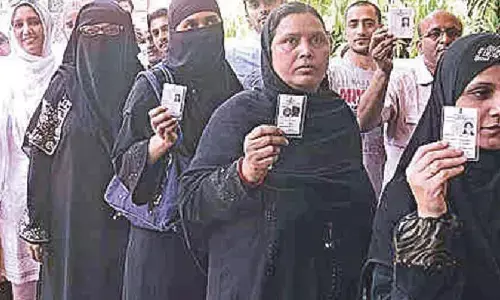Key challenges of comprehensive agriculture policy

Chief Minister of Telangana K Chandrasekhar Rao has launched a Comprehensive Agriculture Policy by introducing new cropping pattern under which farmers will have to cultivate crops in demand as recommended by the government. Already Telangana is providing free electricity, investment support, free insurance, substantially increasing irrigation, crop procurement and other input facilities as well as extension services to all the farmers in the State. This promotion ended six decades of agriculture crisis in Telangana and for the first time, small and marginal farmers have started producing large quantities of agricultural output for profitable marketing. As traditional monoculture of rice has been leading to marketing problems and at the same time an ample demand for other crops exists, a way forward towards sustaining farm income was designed.
This policy of introducing new cropping pattern, among others, is aimed at making farming a permanent profitable profession and promote Telangana's agricultural products at home as well as in other parts of India and the world market. Though initial focus has been correctly made on cropping pattern, which could be seen as a win¬¬-win strategy, a comprehensive agriculture policy will have to address step by step a number of other related challenges in future, for example the issue of reforming India's domestic support policies, safeguarding sustainable agriculture and exploring export potential for agriproducts.
We all have been observing that agri-food systems are undergoing rapid transformation. Increasing concentration in processing, trading, marketing and retailing is being observed in all regions and in all segments of production-distribution chains in India and Telangana. The traditional way in which food is produced, without farmers having a clear idea in advance of when, to whom and at what price they are going to sell their crops, is being replaced by practices which resemble to manufacturing processes, with far greater coordination between farmers, processors, retailers and others in the supply chain. Farmers have to increasingly produce to meet the requirements of buyers rather than relying on markets to absorb what they produce.
The regulation sees 50 lakh acres of rice; apart from long corn varieties, the Telangana Sona variety of paddy will alone be cultivated in 10 lakh acres while red gram will be allowed to be produced in another 10 lakh acres. Instead of maize, cotton (also irrigated for higher yields) will be encouraged to be cultivated in 50 lakh acres. The government has also decided to give importance to farming of vegetables in 3.5 lakh acres that are located close to urban areas. As incomes increase, food consumption is changing. Demand for fruits and vegetables (80 % come from outside), animal products and oil seed crops (40% come from outside) and red gram (70% come from outside) are growing and farmers have to diversify production step by step to respond to this profitably.
Therefore, within this win¬-win strategy of linking farmers to markets concept, the intervention model to achieve remunerative prices for agriculture products proposed by the government through its own corporation is highly necessary and will have to be strengthened to tame our conventional market, which is highly imperfect. On the production front, choice of product to grow must definitely take into account not just market demand, but also farmer location, social structure, available infrastructure, farm size, suitability of the land, land tenure situation, farmers' assets, capacity to establish new enterprises etc. Consideration of the risk that farmers may face in diversifying into new products is very important as well as the technologies promoted by the government should be viable for the type of farmer.
Agriculture research, technology transfer studies and extension guidelines will have to play a key role in this process.
Minimum Support Price (MSP), apart from export restrictions and prohibitions in certain times, is an important factor contributing towards depressing the domestic prices of agriculture. While the system covers 24 crops, it only involves significant purchases at guaranteed prices for rice, wheat and cotton. Apart from Telangana, where a 100% purchase by MSP is guaranteed, the overall India's picture of mere 6% of farmers participating reflects its inefficient implementation. Input subsidies constitute the largest category of government disbursements, with roughly Rs 2 trillion. The largest input subsidies are provided for fertilizers, electricity and irrigation, and, to a lesser extent, for seeds, machinery, credit and crop insurance. While these transfers have played a critical role in increasing production and should be streamlined for their effective use, their indiscriminate use without taking natural resource management into consideration is contributing to unsustainable agriculture as well as towards fiscal deficit of the government.
Most striking example in this regard is Punjab agriculture today. While intensive farming played havoc with soil fertility, necessitating application of more chemical fertilizers year after year resulting in decrease of real output, excessive use and abuse of chemical pesticides has contaminated the food chain. Consumer subsidies are implemented through PDS in India. While PDS provides a means to strengthen consumers' purchasing power, the main weakness of the system relates to the high level of 'leakage' of food grains – due to poor targeting, wasteful management of stocks or, in certain cases, outright corruption. Purchases made to support the MSP have also tended to overshoot requirements, leading to the accumulation of stocks far in excess of the norms established by the government.
As far as consumer support is concerned, a possible option would consist in moving from an in-kind food distribution to cash transfers, in order to enhance the purchasing power of the target group in the market. This could help reduce the costs of stockpiling and food distribution, while at the same time addressing the problem of leakage and waste. For example, the Telangana government in this regard has initiated a move where in the consumer preferences of rice varieties of the local people within PDS are being taken into account by encouraging the cultivation of such varieties for local consumption creating a win-win situation. The data network to identify the needy consumers for eventual cash transfers should be developed in a comprehensive way as has been done through Sakala Janula Survey in Telangana.
In contrast to policies of the US and Europe, where farmers were offered heavy subsidies to export their produce in the past, the policymakers in India used restrictive export policies for most of the agriproducts to keep domestic prices low. To compensate the farmers, the government introduced minimum support prices (MSP) and input subsidies, especially for rice and wheat leading to their excessive cultivation. One consequence of such approach is that we are far from being secure in the field of edible oils among a number of other products such as pulses, vegetables, fruits etc. India produces less oilseeds and imports about 65 percent of its annual requirement of 23 million MT at a cost of Rs 75,000 crore and by 2030, it will be importing 70 percent of edible oils with about Rs 1 lakh crore.
India is second in global agricultural production, but its share of world agricultural exports is as low as 2%. Agricultural exports' contribution to India's GDP is also as low as 2%, lower than other developing agrarian country. In order to improve the sector, certain policy reforms are necessary (1) phase-out the built-in consumer bias (that is anti-farmer) in agri-policies which has been initiated in Telangana (2) create business space for private players (including Farmer Producer Organizations) to have integrated markets across space and time (3) use an income policy approach (through direct cash/benefit transfer) to protect both poor consumers and small farmers like in Telangana (4) create a predictable and a stable agri-trade policy and streamline the high customs duties on India's export-competing products like rice.
(The writer is a Member of Legislative Assembly, Telangana & Humboldt expert in agriculture, environment and cooperation)
















